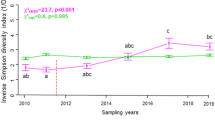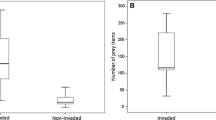Abstract
Effectively managing invaded grasslands requires a comprehensive understanding of effects of the invader on key species in those ecosystems. Annual grasses, such as cheatgrass (Bromus tectorum L.) and medusahead (Taeniatherum caput-medusae), are significant invaders of grasslands in the western United States and their presence has been found to influence vegetation and vertebrate wildlife. However, little is known about how annual grass invasions affect invertebrates, including spiders, which provide significant ecosystem services. This study examined the response of an important grassland predator, ground crab spiders (Thomisidae: Xysticus), to annual grass invasion in semi-arid grasslands of eastern Oregon. Crab spiders are ambush predators, and Xysticus is a ground-dwelling genus that forages primarily in litter. Spiders were sampled using pitfall traps and cover of invasive annual grasses and litter was surveyed for three years (2014–2016). Results revealed that abundance of ground crab spiders was positively associated with increased cover of invasive annual grasses and litter. A positive relationship between invasive annual grass and litter cover suggests that cheatgrass and medusahead contribute significantly to litter, which may result in the higher observed Xysticus abundance. Increased litter may provide these spiders with more prey, refugia, and foraging habitat or modulate extreme temperature and moisture conditions in this arid grassland.



Similar content being viewed by others
References
Bagchi S, Briske DD, Bestelmeyer BT, Ben WuX (2013) Assessing resilience and state-transition models with historical records of cheatgrass Bromus tectorum invasion in North American sagebrush-steppe. J Appl Ecol 50:1131–1141. https://doi.org/10.1111/1365-2664.12128
Bates, DM, Maechler M, Bolker B (2012) lme4: Linear Mixed-Effects Models Using S4 classes. R Package Version 0.999999-0
Bell JR, Wheater CP, Cullen WR (2001) The implications of grassland and heathland management for the conservation of spider communities: a review. J Zool 255:377–387. https://doi.org/10.1017/S0952836901001479
Belnap J, Phillips SL (2001) Soil biota in an ungrazed grassland: response to annual grass (Bromus tectorum) invasion. Ecol Appl 11:1261–1275. https://doi.org/10.1890/1051-0761(2001)011%5b1261:SBIAUG%5d2.0.CO;2
Davies KW, Boyd CS (2018) Longer-term evaluation of revegetation of medusahead-invaded sagebrush steppe. Rangel Ecol Manag 71:292–297
DeVore JL, Maerz JC (2014) Grass invasion increases top-down pressure on an amphibian via structurally mediated effects on an intraguild predator. Ecology 95:1724–1730
Hall LK (2012) Effect of cheatgrass on abundance of the North American deermouse (Peromyscus maniculatus). Southwest Nat 57:166–169. https://doi.org/10.1894/0038-4909-57.2.166
Jiménez-Valverde A, Lobo JM (2007) Determinants of local spider (Araneidae and Thomisidae) species richness on a regional scale: climate and altitude vs habitat structure. Ecol Entomol 32:113–122. https://doi.org/10.1111/j.1365-2311.2006.00848.x
Kappes H, Lay R, Topp W (2007) Changes in different trophic levels of litter-dwelling macrofaunal associated with giant knotweed invasion. Ecosystems 10:734–744. https://doi.org/10.1007/s10021-007-9052-9
Kennedy PL, DeBano SJ, Bartuszevige A, Lueders A (2009) Effects of native and nonnative grassland plant communities on breeding passerine birds: implications for restoration of Northwest bunchgrass prairie. Restor Ecol 17:515–525. https://doi.org/10.1111/j.1526-100X.2008.00402.x
Knapp PA (1996) Cheatgrass (Bromus tectorum L.) dominance in the Great Basin Desert: history, persistence, and influences to human activities. Global Environ Change 6:37–52. https://doi.org/10.1016/0959-3780(95)00112-3
Looney CN, Zack RS (2008) Plant community influence on ground beetle (Coleoptera: Carabidae) species richness and abundance. Nat Area J 28:168–170. https://doi.org/10.3375/0885-8608(2008)28%5b168:PCIOGB%5d2.0.CO;2
McCary MA, Mores R, Farfan MA, Wise DH (2016) Invasive plants have different effects on trophic structure of green and brown food webs in terrestrial ecosystems: a meta-analysis. Ecol Lett 19:328–335
Newbold TAS (2005) Desert horned lizard (Phrynosoma platyrhinos) locomotor performance: the influence of cheatgrass (Bromus tectorum). Southwest Nat 50:17–23. https://doi.org/10.1894/0038-4909(2005)050%3c0017:DHLPPL%3e2.0.CO;2
Ostoja SM, Schupp EW, Sivy K (2009) Ant assemblages in intact big sagebrush and converted cheatgrass-dominated habitats in Tooele County, Utah. West N Am Nat 69:223–234. https://doi.org/10.3398/064.069.0211
Pearson DE (2009) Invasive plant architecture alters trophic interactions by changing predator abundance and behavior. Oecologia 159:549–558
Pearson DE (2010) Trait- and density-mediated indirect interactions initiated by an exotic invasive plant autogenic ecosystem engineer. Am Nat 176:394–403
Pyke DA (1999) Invasive exotic plants in sagebrush ecosystems of the Intermountain West. In: Entwistle PG, DeBolt AM, Kaltenecker JH, Steenhof K (eds) Proceedings: sagebrush steppe ecosystems symposium; Boise, Idaho; June 23–25, 1999. Boise, Idaho: Bureau of Land Management, pp 43–54
R Development Core Team (2017) R: A language and environment for statistical computing. R Foundation for Statistical Computing, Vienna, Austria
Richardson KA, West SD, Gitzen RA (2013) Cheatgrass (Bromus tectorum) dominates cheek pouch contents of the Great Basin pocket mouse (Perognathus parvus). West N Am Nat 73:158–167. https://doi.org/10.3398/064.073.0205
Rickard WH, Haverfield LE (1965) A pitfall trapping survey of darkling beetles in desert steppe vegetation. Ecology 46:873–875. https://doi.org/10.2307/1934023
Settle WH, Ariawan H, Astuti ET, Cahyana W, Hakim AL, Hindayana D, Lestari AS (1996) Managing tropical rice pests through conservation of generalist natural enemies and alternative prey. Ecology 77:1975–1988. https://doi.org/10.2307/2265694
Smith DiCarlo LA, DeBano SJ (2018) Spider community responses to grassland restoration: balancing tradeoffs between abundance and diversity. Restor Ecol. https://doi.org/10.1111/rec.12832
Smith-Ramesh LM (2017) Invasive plant alters community and ecosystem dynamics by promoting native predators. Ecology 98:751–761
Stewart G, Hull AC (1949) Cheatgrass (Bromus tectorum L.)—an ecologic intruder in southern Idaho. Ecology 30:58–74. https://doi.org/10.2307/1932277
Winter B (2013) Linear models and linear mixed effects models in R with linguistic applications. arXiv:1308.5499, http://arxiv.org/pdf/1380.5499.pdf
Wolkovich EM (2010) Nonnative grass litter enhances grazing arthropod assemblages by increasing native shrub growth. Ecology 91:756–766. https://doi.org/10.1890/09-0147.1
Wolkovich EM, Bolger DT, Holway DA (2009) Complex responses to invasive grass litter by ground arthropods in a Mediterranean scrub ecosystem. Oecologia 161:697–708. https://doi.org/10.1007/s00442-009-1425-7
Zack RS, Looney C (2012) Habitat distribution and seasonality of the northern scorpion, Paruroctonus boreus (Girard) (Scorpiones: Vaejovidae), at the Hanford Site, southcentral Washington State. Pan-Pac Entomol 88:292–298. https://doi.org/10.3956/2009-24.1
Zouhar K (2003) Bromus tectorum. In: Fire effects information system. U.S. Department of Agriculture, Forest Service, Rocky Mountain Research Station, Fire Sciences Laboratory. http://www.fs.fed.us/database/feis/plants/graminoid/brotec/all.html
Zuur AF, Ieno EN, Walker NJ, Saveliev AA, Smith GM (2009) Mixed effects models and extensions in ecology with R. Springer, New York
Acknowledgements
We thank Leslie Nelson at The Nature Conservancy Boardman Grasslands Preserve and interns from Oregon State University that helped in the field and laboratory, including SR Roof, EM Campbell, KL Kirby, L McDaniel, LK Waianuhea, and BE Price. This work was supported by the Oregon State University Branch Experiment Station Internship Program, a USDA Western Sustainable Agriculture Research and Education Graduate Student Grant (#GW16-016), The Nature Conservancy Oren Pollak Memorial Student Research Grant for Grassland Science, The Soil and Water Conservation Society Kenneth E. Grant Research Scholarship, The Prairie Biotic Small Research Grants Program, The Society for Ecological Restoration Northwest Chapter Student Research Grant, and a grant from the Oregon State University General Research Fund. The comments and suggestions of two anonymous reviewers greatly improved this manuscript.
Author information
Authors and Affiliations
Corresponding author
Additional information
Publisher's Note
Springer Nature remains neutral with regard to jurisdictional claims in published maps and institutional affiliations.
Rights and permissions
About this article
Cite this article
Smith, L.J., Smith DiCarlo, L.A. & DeBano, S.J. Ground crab spiders (Thomisidae: Xysticus) more abundant in grasslands invaded by cheatgrass (Bromus tectorum) and medusahead (Taeniatherum caput-medusae). Biol Invasions 21, 1473–1479 (2019). https://doi.org/10.1007/s10530-019-01926-w
Received:
Accepted:
Published:
Issue Date:
DOI: https://doi.org/10.1007/s10530-019-01926-w




